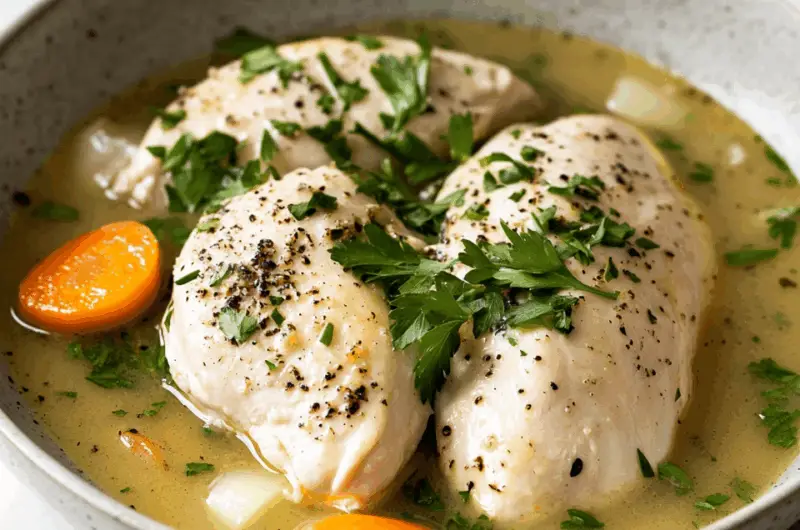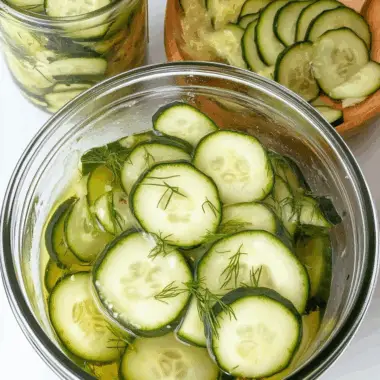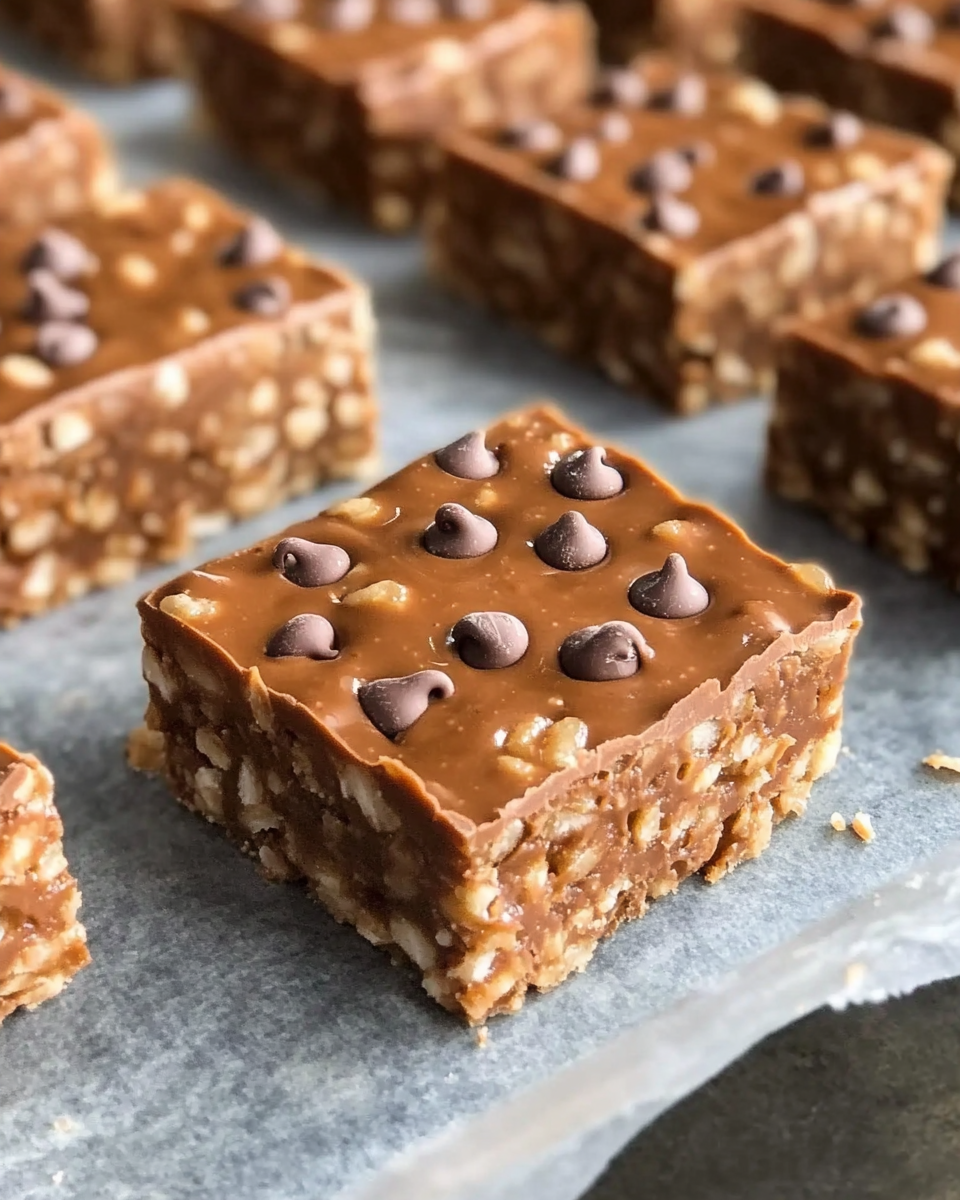Poached chicken breast is a wonderfully versatile dish that highlights the pure, tender flavor of the chicken without any added fats or heavy seasoning. The gentle cooking method locks in moisture, resulting in a succulent texture that’s perfect on its own or as a base for salads, sandwiches, or light dinners.
This recipe’s simplicity makes it a staple for healthy eating and meal prep, while the aromatic broth infused with herbs and vegetables provides a comforting background flavor. Whether you’re looking to maintain a nutritious diet or want an elegant yet easy protein option, poached chicken breast delivers every time.
Full Recipe:
-
2 skinless, boneless chicken breasts
-
1 small onion, peeled and halved
-
1 carrot, peeled and halved
-
1 celery stalk, halved
-
4 black peppercorns
-
1 bay leaf
-
1 teaspoon salt
-
Fresh parsley or thyme sprigs (optional)
-
Water, enough to cover the chicken
Directions:
-
Place the chicken breasts in a wide saucepan or shallow pan. Add the onion, carrot, celery, peppercorns, bay leaf, salt, and herbs if using.
-
Pour in enough cold water to cover the chicken by about 1 inch.
-
Slowly bring to a gentle simmer over medium heat. Avoid boiling to keep the chicken tender.
-
Once simmering, reduce the heat to low and cover the pan with a lid. Poach the chicken gently for 15-20 minutes, or until the chicken is cooked through (internal temperature should reach 75°C / 165°F).
-
Remove the chicken from the broth and let rest for a few minutes before slicing or shredding.
-
Strain the broth to use as a flavorful stock for soups or sauces if desired.
Prep Time: 5 minutes | Cooking Time: 20 minutes | Total Time: 25 minutes
Kcal: 165 kcal (per serving) | Servings: 2 servings
The Art and Science of Poaching Chicken Breast
Poaching chicken breast is a cooking method that has been cherished by chefs and home cooks alike for its ability to deliver tender, juicy, and flavorful chicken without adding excess fat or calories. Unlike grilling or frying, poaching gently cooks the chicken in liquid at a low temperature, typically just below boiling. This slow and gentle heat allows the meat to cook evenly and retain moisture, which results in a delicate texture that many find superior to other cooking techniques.
One of the key benefits of poaching is the control it gives over the chicken’s doneness. Because the temperature remains moderate throughout the process, it is difficult to overcook the meat, which can often happen with high-heat methods. This makes poaching especially ideal for lean cuts like chicken breast, which can dry out quickly when exposed to intense heat.
Why Poached Chicken Breast Is a Healthy Choice
From a nutritional standpoint, poached chicken breast is an excellent choice for anyone looking to maintain a balanced diet. Chicken breast is naturally low in fat and high in protein, making it a perfect option for muscle building, weight management, and overall health. The poaching method preserves these qualities because it does not require additional oils, butter, or heavy sauces.
Moreover, the broth created during poaching is not only flavorful but also nutrient-rich, especially when made with aromatic vegetables and herbs. This broth can be repurposed for soups, stews, or cooking grains, adding layers of flavor and nutrition to other meals.
Flavor Profiles and Variations
While the basic poached chicken breast recipe focuses on gentle cooking with simple aromatics like onion, carrot, celery, bay leaf, and peppercorns, there is tremendous room for creativity in this method. You can infuse the poaching liquid with fresh herbs such as thyme, rosemary, or parsley, or even add citrus slices like lemon or orange for a bright, zesty note.
The poached chicken itself is wonderfully versatile because it acts as a blank canvas. Once cooked, it can be shredded, sliced, or chopped and incorporated into a wide array of dishes. From vibrant salads and wholesome grain bowls to comforting sandwiches and hearty soups, poached chicken can elevate many meals with its tender texture and subtle flavor.
Practical Uses and Meal Prep Benefits
One of the biggest advantages of poached chicken breast is its suitability for meal prepping. Because it is easy to make in bulk and keeps well in the refrigerator or freezer, it is a convenient protein option for busy lifestyles. Preparing a batch of poached chicken at the start of the week can save valuable cooking time and provide a nutritious base for lunches and dinners.
The neutral flavor profile means it pairs well with countless seasonings, sauces, and sides. You can dress it up with pesto, salsas, or creamy yogurts, or keep it simple with steamed vegetables and a drizzle of olive oil. This flexibility helps prevent mealtime monotony, making healthy eating more enjoyable and sustainable.
Tips for Perfectly Poached Chicken Breast
Achieving the perfect poached chicken breast is about technique as much as it is about ingredients. Using fresh, high-quality chicken ensures the best texture and taste. It’s important to bring the poaching liquid to a gentle simmer rather than a rapid boil, as high heat can toughen the meat.
Covering the pan during cooking helps to evenly distribute the heat and infuse the chicken with the flavors from the aromatics. Letting the chicken rest after poaching allows the juices to redistribute throughout the meat, enhancing moisture retention and flavor.
For even more depth, some cooks like to brine the chicken beforehand in a simple saltwater solution. This helps the meat retain moisture during cooking and can add a subtle seasoning throughout.
How to Serve Poached Chicken Breast
Poached chicken breast can be served in countless ways depending on your mood and occasion. For a light and refreshing meal, slice it thinly and serve over a bed of crisp greens with a citrus vinaigrette. For a comforting dinner, shred the chicken and mix it into warm rice or pasta dishes.
It also lends itself beautifully to international cuisines. Think chicken salad with a creamy yogurt dressing and fresh herbs for a Mediterranean twist, or shredded chicken with ginger and scallions in an Asian-inspired noodle bowl.
Culinary Pairings and Complementary Ingredients
Pairing poached chicken breast with the right ingredients can amplify its flavor and create a balanced dish. Fresh herbs like basil, dill, or cilantro add brightness and contrast the mild flavor of the chicken. Acidic components such as lemon juice, vinegar, or pickled vegetables bring a welcome zing that enlivens the palate.
Rich elements like avocado, nuts, or cheeses can add texture and richness, while seasonal vegetables provide color, nutrition, and crunch. Whole grains like quinoa, barley, or brown rice complement the lean protein, making the meal more filling and well-rounded.
Environmental and Ethical Considerations
Choosing chicken breast for your meals also offers a way to enjoy protein with a relatively lower environmental footprint compared to red meats. Sustainable sourcing, such as opting for organic or free-range chicken, supports ethical farming practices and often results in better-tasting, healthier meat.
By incorporating poached chicken breast into your diet, you contribute to mindful eating habits that favor health, animal welfare, and environmental sustainability.
Conclusion
Poached chicken breast is a timeless, healthy, and versatile culinary staple that deserves a spot in every kitchen. Its gentle cooking method preserves moisture and tenderness while highlighting the natural flavor of the chicken. This method not only supports a balanced diet through its lean protein content and low-fat preparation but also offers a simple yet elegant base for countless dishes.
Whether you’re a novice cook or a seasoned chef, mastering the art of poaching chicken breast can elevate your cooking repertoire. Its adaptability to various cuisines and meal types makes it a practical and delicious solution for everyday meals and special occasions alike. Embrace this technique to enjoy meals that are both nourishing and satisfying without sacrificing flavor or convenience.








